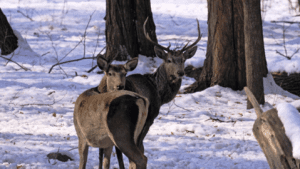TAG: GS 3: ECOLOGY AND ENVIRONMENT
THE CONTEXT: The elusive and critically endangered hangul, a native species of deer in Kashmir, has displayed a robust rutting or mating season, offering hope for its population resurgence.
EXPLANATION:
- Experts are optimistic about the hangul population surpassing 300 this spring, marking a significant achievement after over three decades of decline.
- To facilitate undisturbed rutting, Dachigam National Park, the habitat of hangul, was temporarily closed to visitors between September 25 and October 18 previous year, highlighting the conservation efforts to protect the critical mating period.
Historical Decline and Recent Resurgence:
- Population Decline Since 1947: Since 1947, the hangul population faced a sharp decline, dwindling from around 2000 to 384 by 1968.
- The population plummeted further in the 1990s due to political turmoil, with an estimated 140 to 160 hanguls in 1992.
- Despite challenges, recent years have seen a steady increase, with the population rising from 183 in 2015 to 261 in 2021.
Conservation Efforts and Environmental Challenges:
- Habitat Preservation: Efforts by the Wildlife department include securing corridors, especially the Wangath-Naranag corridor, and regulating traffic on highways to ensure the safe movement of hangul groups.
- Male-Female Ratio Imbalance: Challenges include a skewed male-female ratio, with 19.2 males per 100 females, falling significantly below the ideal ratio of 40-50 males per 100 females.
- Predator Threats: Hangul faces threats from leopards and Asiatic Black Bears, with research suggesting they constitute about 25% of the leopard diet in Dachigam.
- Climate Impact: Global warming and reduced snow cover in Upper Dachigam have led to dried-up drainages and potential habitat disturbances.
- Water Scarcity Concerns: Dried-up drainages may force hanguls, especially lactating females, to move towards disturbed habitats, increasing vulnerability to predators or sheep dogs.
Conservation Initiatives and Future Plans:
- Protection Mechanism: The J&K Wildlife department has identified 10 hangul sites for enhanced protection and sustenance.
- Captive Breeding: A captive breeding facility has been established at Shikargah Tral, with plans to use assisted reproductive techniques (ART) to augment the hangul population.
- Genome Resource Banking: Radio-collaring initiatives in 2013 and 2020 have paved the way for genome resource banking and the establishment of an embryo bank, crucial for conservation efforts.
Hangul:
- The hangul also called as Kashmir stag is a subspecies of Central Asian red deer endemic to Kashmir and surrounding areas.
- It is found in dense riverine forests in the high valleys and mountains of Jammu and Kashmir and northern Himachal Pradesh.
- In Kashmir, it is found primarily in the Dachigam National Park where it receives protection.
- A small population has also been witnessed in Overa-Aru Wildlife Sanctuary in south Kashmir.
- It has been is classified as Critically Endangered by the IUCN Red List, as its population has declined drastically over the years due to habitat loss, overgrazing by domestic livestock, poaching, predation, diseases and human-wildlife conflicts.

Dachigam National Park:
- The actual beauty of the park lies in the deep valleys, rocky outcrops, steep wooded slopes and rolling alpine pastures.
- Being located in a mountainous area, Dachigam National Park faces a huge variation in altitude that ranges from 1600 m to 4200 m above sea level.
- This variation in altitude categorises Dachigam National Park into two regions- the upper region and the lower region.
- It is extremely rich in Wild Cherry, Pear, Plum, Peach, Apple, Apricot, Walnut, Chestnut, Oak, Willow, Poplar, Chinar, Birch, Pine and Elm.
- Fauna: Hangul (Kashmir Stag), Musk deer, Brown Bear, Leopards, Jungle Cats, Himalayan black bear, and a few species of wild goats like the markhor and ibex.
Genome Resource Banking:
- Genome resource banking is the systematic collection, storage, and redistribution of biomaterials in an organized, logistical, and secure manner.
- Genome cryobanks usually contain biomaterials and associated genomic information essential for progression of biomedicine, human health, and research.
- Many developed and developing countries have allocated substantial resources to establish genome resources banks which are responsible for safeguarding scientifically, economically, and ecologically important wild type, mutant, and transgenic plants, fish, and local livestock breeds, as well as wildlife species.

